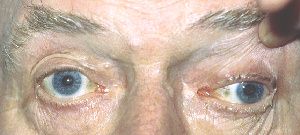Third nerve palsy

'Down and out' of the left globe in complete third nerve palsy. |
|
The patient may have complete third nerve palsy with the classical signs or partial palsy with aberrant regeneration. a. Features of complete third nerve palsy. The patient has a complete ptosis. The eye under the lid
is depressed and abducted (down and out). The pupil is dilated and unreactive
to light or accommodation. The fourth nerve and sixth nerve function are
intact as
Other examination:
The affected eye has a partial ptosis. Pupil of the affected side may be larger or the same size as the opposite pupil. Elevation, adduction and depression of the affected side are limited. But abduction and intortion are normal. Other examination:
|
Questions:
1. Why is the pupil affected in compressive third nerve
palsy but not if the cause is infarction?